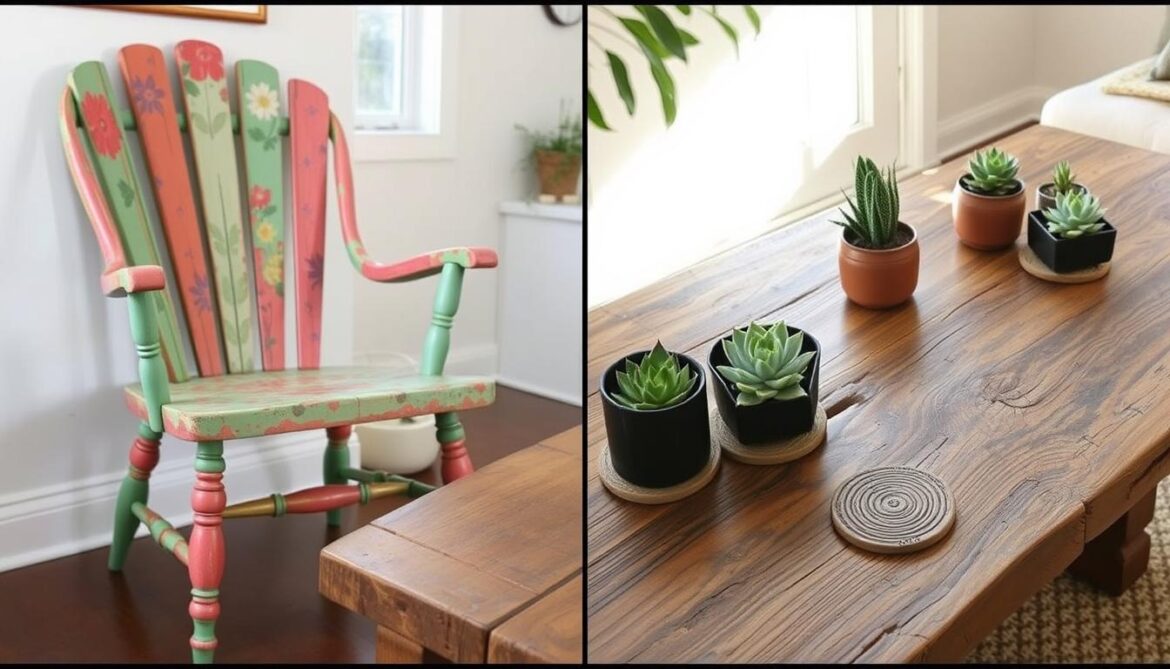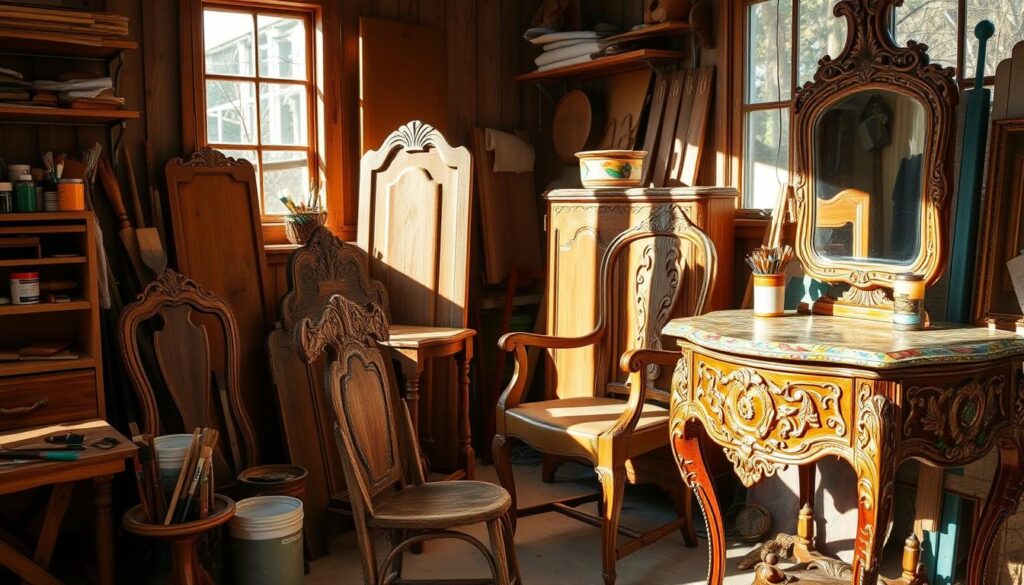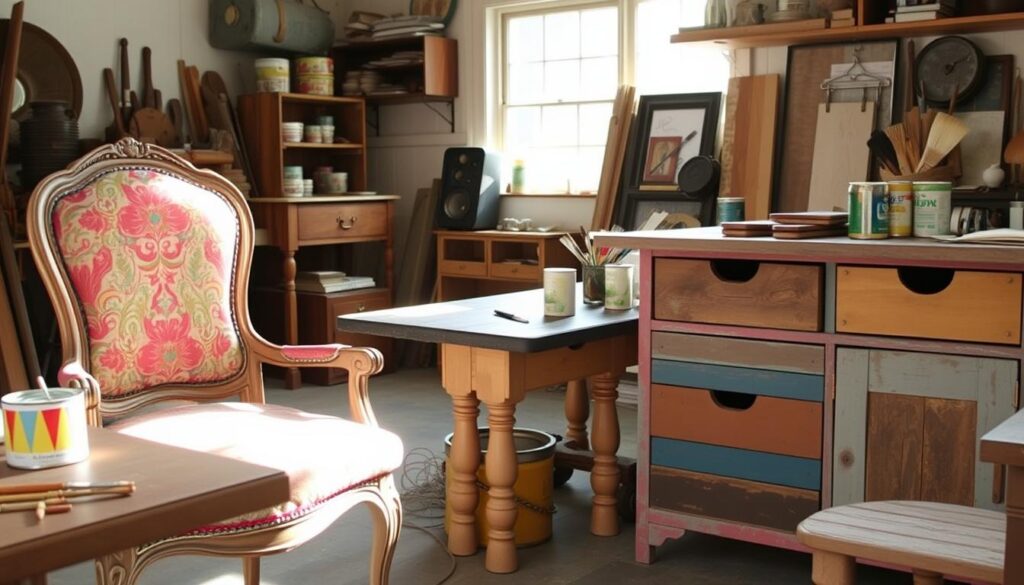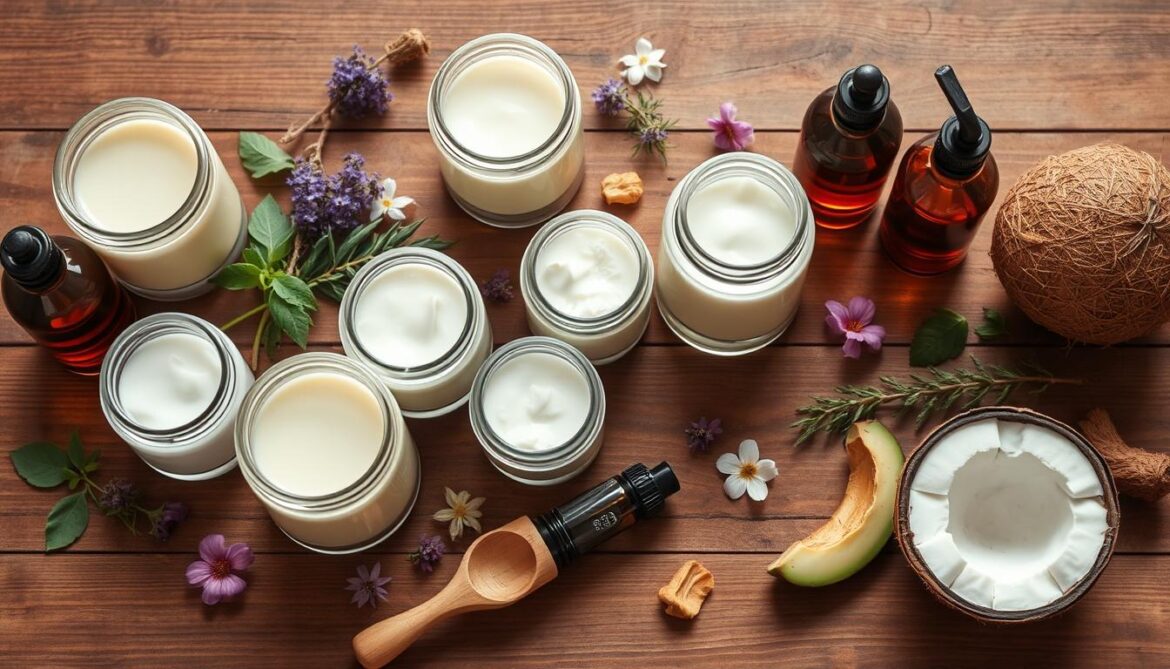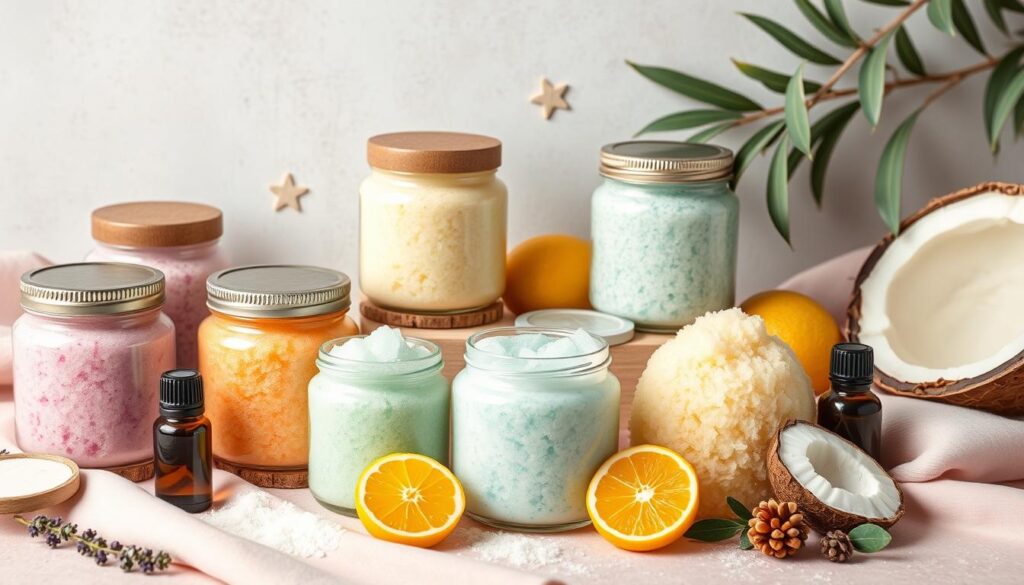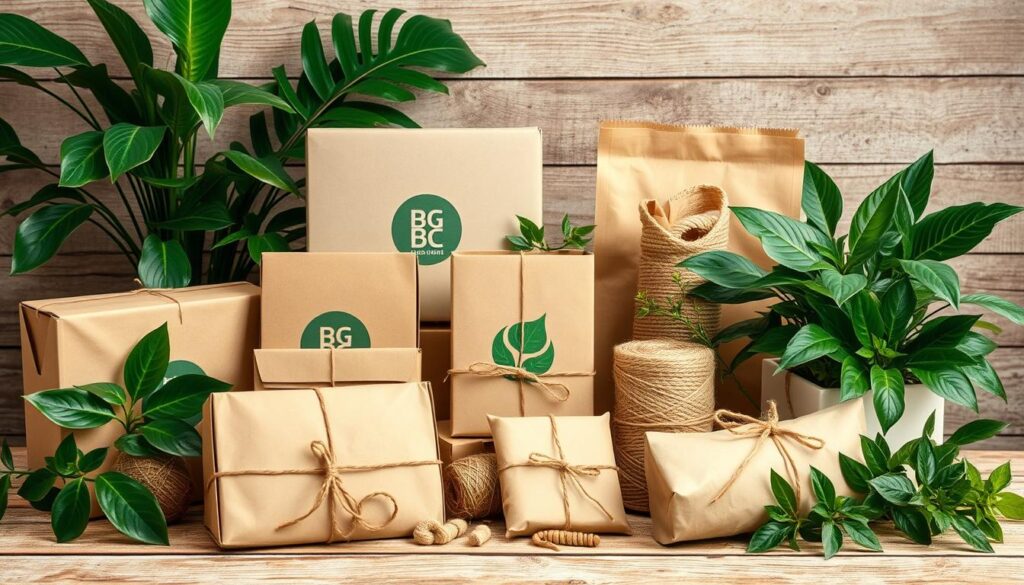Imagine turning an old, worn-out piece of furniture into something beautiful and unique. This is what upcycling is all about. It’s a creative way to give old items a new life, making them functional and stylish.
Upcycling is good for the planet and your wallet. It lets you create pieces that are truly yours. Whether you love DIY projects or want to be eco-friendly, upcycling is a great choice.
Why Upcycle Old Furniture?
Upcycling old furniture is a creative and eco-friendly way to breathe new life into outdated items. It reduces waste, conserves resources, and lets you create unique pieces that show your style. This method is good for the environment and lets you express your creativity in your home.
Upcycling gives old furniture a new purpose. With a bit of imagination and DIY skills, you can turn an old piece into something stunning. For instance, an old dresser can become a kitchen island or coffee table. An old door can be repurposed as a headboard or room divider.
- Reduced waste and conservation of resources
- Cost savings compared to buying new furniture
- Opportunity to express your creativity and add a personal touch to your living space
By upcycling, you can make your living space more sustainable and beautiful. It’s a way to renovate and repurpose old furniture in a creative and eco-friendly manner.
Benefits of Upcycling
Upcycling has many benefits, like reducing waste and saving money. It lets you create unique pieces that show your style and add personality to your home.
Environmental Impact
The environmental benefits of upcycling are huge. It cuts down on waste and saves natural resources. By giving old furniture a new life, you help reduce the need for new, resource-intensive furniture.
Cost Savings
Upcycling is also a budget-friendly way to update your home. It saves you money on new furniture and lets you create pieces that are both unique and functional.
Choosing the Right Furniture for Upcycling
When upcycling, picking the right furniture is key. Look for pieces with strong frames and unique features. High-quality materials are also important. Think about how you can turn them into something new and exciting.
When searching for furniture to upcycle, remember the importance of condition and material. Check if the piece is sturdy and if it has any damage. Look for materials like wood or metal that can be fixed or reused. Be creative and think differently when upcycling furniture.
Identifying Good Candidates
- Look for pieces with unique details, such as carvings or intricacies
- Consider the material and condition of the furniture
- Think about the piece’s full possibility and how you can change it
Assessing Condition and Material
When checking a piece’s condition and material, consider these points:
| Factor | Considerations |
|---|---|
| Material | Look for high-quality wood, metal, or other materials that can be refinished or repurposed |
| Condition | Check for damage, wear, or structural issues that may affect the stability of the piece |
| Potential | Think about how you can transform the piece and give it new life |
By thinking about these points, you can find the perfect furniture to upcycle. You can create unique, one-of-a-kind pieces that show your style and creativity.
Essential Tools and Materials for Upcycling
To start upcycling old furniture, you need the right tools and materials. Upcycling needs basic and special tools to get the job done. You’ll need sandpaper, paint brushes, and more to fix and change your furniture.
Having the right tools and materials is key for upcycling. Some must-haves include:
- Electric sander for smoothing out surfaces
- Paint sprayer for even coats
- Clamps for holding pieces together
You’ll also need various supplies like paints, stains, and finishes. The material you’re working with decides the best supplies. For example, a wooden chair might need a wood stain to show off the wood grain.
Remember to stay safe while upcycling. Wear gloves and safety glasses to avoid injuries. With the right tools, materials, and safety, you can make unique and useful furniture. Upcycling is a fun and rewarding DIY project.
| Tool | Description |
|---|---|
| Sandpaper | For smoothing out surfaces |
| Paintbrushes | For applying paint and stains |
| Clamps | For holding pieces together |
Preparation Steps Before Upcycling
Before starting your upcycling project, it’s key to prepare your furniture well. This ensures your final piece is of high quality and lasts long. Each type of furniture needs a different approach to preparation.
The condition of your furniture greatly affects your upcycling outcome. Cleaning your furniture is the first step. This means removing dirt, grime, and old wax from the surface. Use a gentle cleaner and a soft cloth to wipe down the furniture, ensuring you remove any stuck debris.
Cleaning and Repairing
After cleaning, repairing damages is vital. This includes fixing scratches, dents, or loose joints. Use wood filler for holes or cracks, then sand it down for a smooth finish. If the damage is severe, consider a professional’s help.
Once your furniture is clean and repaired, you can dive into the upcycling process. This is where you can get creative and transform your old furniture into something unique that shows your style.
Removing Old Finish and Hardware
Removing old finish and hardware is another critical step. This means stripping off old paint or varnish and taking off knobs or handles. You can use sanding or chemical strippers to remove the old finish. After removing it, you can think about the new finish you want, like a fresh coat of paint or varnish.
By following these steps, you can ensure your upcycling project is successful. Always work safely and wear protective gear when needed. With patience and creativity, you can make your old furniture into something beautiful and useful that you’ll enjoy for years.
| Preparation Step | Importance |
|---|---|
| Cleaning | High |
| Repairing | High |
| Removing Old Finish and Hardware | Medium |
Painting Techniques for Furniture Upcycling
Painting is a great way to give old furniture a new look. With the right techniques and materials, you can make unique pieces that show off your style. Upcycling means giving old items a new life, and painting is a big part of that.
First, pick the right paint for your furniture. Think about the material, finish, and how long it will last. You can choose from chalk paint, latex paint, or oil-based paint. Each has its own good and bad points, so do your homework before deciding.
Popular Painting Techniques
After picking your paint, try out different techniques. Some favorites include:
- Distressing: making a piece look old by sanding or scraping paint off
- Color washing: using a thin layer of paint for a soft look
- Ombre: mixing colors for a cool, multi-tonal effect
These methods add depth and interest to your upcycled furniture. By mixing and matching, you can make pieces that really stand out.
Finishing Touches
After painting, apply a clear coat or sealant to protect it. This step is key to keeping your furniture looking good for a long time. By following these tips, you can make amazing pieces that show off your creativity.
| Technique | Description |
|---|---|
| Distressing | Creating a worn, vintage look by sanding or scraping away paint |
| Color washing | Applying a translucent layer of paint to achieve a soft, muted effect |
| Ombre | Gradating colors to create a beautiful, multi-tonal effect |
Staining and Refinishing Wood Furniture
Upcycling old furniture is a creative way to make new, useful items. Staining and refinishing wood furniture keeps the wood’s natural look. You need to pick the right stain for your project, thinking about the wood type and color you want.
There are many stains to choose from, like oil-based, water-based, and gel stains. Each has its own benefits and drawbacks. The right stain depends on your project’s needs. You can pick from light, natural colors to darker, more dramatic ones.
Popular ways to apply stain include foam brushes, lint-free cloths, or spray guns. It’s important to follow the stain’s instructions and be safe. This way, you’ll get a beautiful finish that highlights the wood’s grain, turning your furniture into a work of art.
Selecting the Right Stain
- Consider the type of wood and its natural color
- Think about the desired color and finish
- Choose between oil-based, water-based, and gel stains
Techniques for Application
Apply the stain with a foam brush, lint-free cloth, or spray gun. Always follow the manufacturer’s instructions.
Adding New Hardware and Accessories
Upcycling furniture can be a game-changer with new hardware and accessories. A bit of creativity can transform an old piece into something stylish. Start by looking into DIY furniture ideas, like swapping old knobs for new handles or adding decorative legs.
It’s key to pick hardware and accessories that match your furniture’s style. For vintage pieces, choose hardware with a vintage vibe. Modern furniture calls for sleek, contemporary designs. Some great DIY ideas include:
- Adding new handles or knobs to a dresser or cabinet
- Installing decorative legs on a table or chair
- Using metallic leaf or other decorative materials to add a touch of elegance
Remember, upcycling is all about being creative and having fun. Don’t hesitate to try new things and don’t worry if it doesn’t go as planned. With patience and practice, you can make unique furniture that shows off your style and adds personality to your home.
Upholstery Options for Furniture
Upholstery can greatly change how furniture looks and works. You can pick from many fabrics like cotton, linen, and velvet. For example, a vintage armchair can get a bold, patterned fabric for a colorful, textured look.
Think about the furniture and its use when choosing upholstery. A dining chair might need a tough, stain-resistant fabric. But a decorative ottoman could get a luxurious, high-pile fabric for elegance.
Selecting Fabric Types
When picking fabric, think about durability, comfort, and style. Also, consider the color, pattern, and any special features like stain resistance. Some good choices include:
- Cotton: a durable, versatile fabric for many projects
- Linen: a natural, textured fabric for elegance
- Velvet: a luxurious, soft fabric for color and texture
DIY Upholstery Steps
After picking your fabric, start the DIY upholstery. This means removing old upholstery, fixing the structure, and attaching the new fabric. You can find tutorials online or take a class to learn.
Tips for Professional-Looking Results
For professional results, focus on details. Match patterns and stripes well, and use a consistent stitch. Adding trim or tassels can also make your piece unique. With practice, you can create beautiful, personalized furniture.
Incorporating Décor Elements
Exploring DIY ideas and upcycling opens up new ways to decorate. You can turn old furniture into beautiful pieces that show off your style. Upcycling is more than just giving old items a new life. It’s about adding special touches that make them stand out.
There are countless ways to add décor elements. You can use stencils and decals for detailed patterns or designs. Decoupage techniques let you add art by applying paper, fabric, or other materials. You can also add texture with fabrics, like tufted surfaces or fabric on drawer fronts.
Techniques for Adding Décor Elements
- Stencils and decals: use them to create detailed patterns or designs on furniture surfaces
- Decoupage techniques: apply paper, fabric, or other materials to furniture for an artistic effect
- Adding texture with fabrics: create tufted surfaces or apply fabric to drawer fronts
By adding these décor elements, you can change a piece of furniture completely. Don’t be shy to try different techniques and see what works for your project. With patience and creativity, you can make unique and beautiful pieces that show off your style and add elegance to any room.
Sustainability in Upcycling Projects
Starting your furniture upcycling journey means thinking about the environment. Upcycling helps reduce waste and gives old furniture a new life. It’s important to do it in a way that’s good for the planet. Use eco-friendly materials like low-VOC paints, natural stains, and recycled fabrics to lower your project’s carbon footprint.
When upcycling, sustainability is very important. You can make a big difference by picking materials that are good for the environment. For example, use reclaimed wood, repurposed metal, or recycled glass. This way, you’ll not only cut down on waste but also create something unique that shows off your style.
- Use eco-friendly materials, such as low-VOC paints and natural stains
- Choose materials that are locally sourced and have a low carbon footprint
- Repurpose and reuse materials whenever possible
- Avoid using materials that are harmful to the environment, such as chemicals and pesticides
By following these tips, you can make beautiful, sustainable furniture. This not only reduces waste but also helps the environment. Upcycling is more than just giving old furniture a new look. It’s about making a positive change for our planet. So, be creative, think differently, and start upcycling your way to a greener future!
| Material | Environmental Impact |
|---|---|
| Low-VOC paints | Low carbon footprint, non-toxic |
| Natural stains | Biodegradable, non-toxic |
| Reclaimed wood | Reduced waste, low carbon footprint |
Showcasing Your Upcycled Creations
After finishing your upcycling project, it’s time to show off your work. You can place your upcycled furniture in different spots in your home. This makes it a highlight or fits right in with your decor.
When posting on social media, good photos are essential. Take clear, bright pictures of your furniture from all sides. Add a short story about your project, like what materials you used and any hurdles you faced. This way, you can connect with others who love upcycling and maybe even inspire them to try it too.
Styling Tips for Display
- Choose a prominent location for your upcycled furniture, such as a living room or entryway.
- Consider the color scheme and style of the room when selecting accessories and decor to complement your upcycled piece.
- Don’t be afraid to experiment with different layouts and arrangements to find the perfect fit for your space.
Creating a Personal Portfolio
A personal portfolio is a great way to document your upcycling journey and showcase your creations to others. You can include photos of your projects, along with descriptions of the materials and techniques used. This will not only help you track your progress but also provide a valuable resource for others who are interested in DIY ideas and upcycling furniture.
| Project | Materials Used | Techniques Employed |
|---|---|---|
| Upcycled Coffee Table | Reclaimed wood, metal legs | Sanding, staining, sealing |
| Refurbished Armchair | Velvet fabric, wooden frame | Upholstery, staining, varnishing |
Common Mistakes to Avoid When Upcycling
Upcycling furniture can be a fun project, but it’s easy to make mistakes. Knowing these common errors can help you avoid them. This way, you can make your old furniture look new again.
Preparation is key in upcycling. Proper cleaning, sanding, and priming are essential. Without these steps, your project might not turn out right. Also, picking the right adhesives is important to avoid a weak bond.
Don’t forget about safety. Upcycling involves power tools and chemicals. Wearing safety gear like gloves and goggles is important. It keeps you safe while you work.
Common mistakes to watch out for:
- Skiping preparation steps
- Overlooking adhesive choices
- Ignoring safety precautions
By avoiding these mistakes, you can make beautiful furniture. Upcycling is a creative hobby that lets you breathe new life into old items. With the right steps, you can create something truly unique and lasting.
Inspiring Upcycling Projects to Try
Starting your upcycling journey is exciting. You’ll find projects that spark your creativity and fit your skill level. Upcycling turns old items into unique, functional pieces that show off your style. It’s a great way to reduce waste and create something special.
Beginners can start with simple projects like painting a side table or changing drawer pulls. These projects help you learn and build confidence. As you get better, you can try more complex projects, like reupholstering a chair or making something new from old items.
Simple Projects for Beginners
- Painting a side table or shelf to give it a fresh new look
- Replacing drawer pulls or knobs with unique hardware
- Upcycling old jars or containers into planters or vases
Intermediate Upcycling Ideas
- Reupholstering a chair or stool to give it a modern twist
- Creating a new piece of furniture from multiple old ones, such as a headboard from an old door
- Adding decorative trim or molding to a piece of furniture
Upcycling is all about trying new things and being creative. Don’t worry about making mistakes – they can lead to amazing results. With practice and patience, you’ll become more confident in your upcycling skills. You’ll create unique, functional pieces that show off your style.
Resources for Further Learning
If you want to keep up with furniture upcycling, there’s a lot to learn. You can find books, guides, online courses, and blogs full of tips and tricks. These resources will help you get better at upcycling and understand more about it.
Books and Guides
Begin with books like “The Complete Guide to Furniture Upcycling” by Barb Blair or “Furniture Makeovers” by Sherry and John Petersik. These guides have detailed steps, creative ideas, and expert advice. They’ll teach you how to turn old furniture into beautiful new pieces.
Online Courses
For hands-on learning, try online courses on furniture upcycling. Sites like Skillshare and Udemy have classes on painting, upholstery, and more. They’re taught by pros who know their stuff.
Blogs and YouTube Channels
Check out blogs and YouTube channels for upcycling inspiration. Sites like “Furniture Fashion” and “Salvage Sisters” show off amazing upcycled projects and share DIY tips. Channels like “Serena & Lily” and “The Rehab Life” give you visual ideas and step-by-step guides.
No matter if you’re new or have been upcycling for a while, these resources will help. They’ll give you the skills and ideas to make your furniture look new again.
FAQ
What is furniture upcycling?
Furniture upcycling is turning old furniture into new, unique pieces. It’s about giving old furniture a fresh look. This can make it look like something entirely new.
What are the benefits of upcycling old furniture?
Upcycling old furniture lets you be creative and save money. It also helps the environment by reducing waste. Plus, it’s a fun way to make something special.
How do I identify good candidates for upcycling?
Look for furniture that’s solid but needs a makeover. Check its material, condition, and design to see if it can be transformed. This will help you choose the right piece for your project.
What are the essential tools and materials needed for furniture upcycling?
You’ll need sandpaper, paint brushes, and power tools like drills. Don’t forget safety gear like gloves and goggles. Also, have different paints, stains, sealers, and new hardware on hand.
What are the important preparation steps before starting an upcycling project?
Start by cleaning the furniture well. Then, fix any damage and remove old finishes and hardware. This gets the surface ready for your makeover.
What are some popular painting techniques for upcycling furniture?
Try techniques like distressing, color washing, and ombre effects for interesting finishes. Choose the right paint for the look you want and for durability.
How can I add new hardware and accessories to upcycled furniture?
Pick unique hardware like handles and knobs to enhance your furniture. You can also add creative accessories like decorative legs or glass panels to make it truly yours.
What are some tips for sustainable upcycling practices?
Use eco-friendly materials like low-VOC paints and recycled fabrics. Try to waste less and use resources wisely. This makes your projects more sustainable.
How can I showcase my upcycled furniture creations?
Post your projects on social media and create a portfolio. Show off your pieces in your home. Join the online upcycling community to share your work and get inspired.
